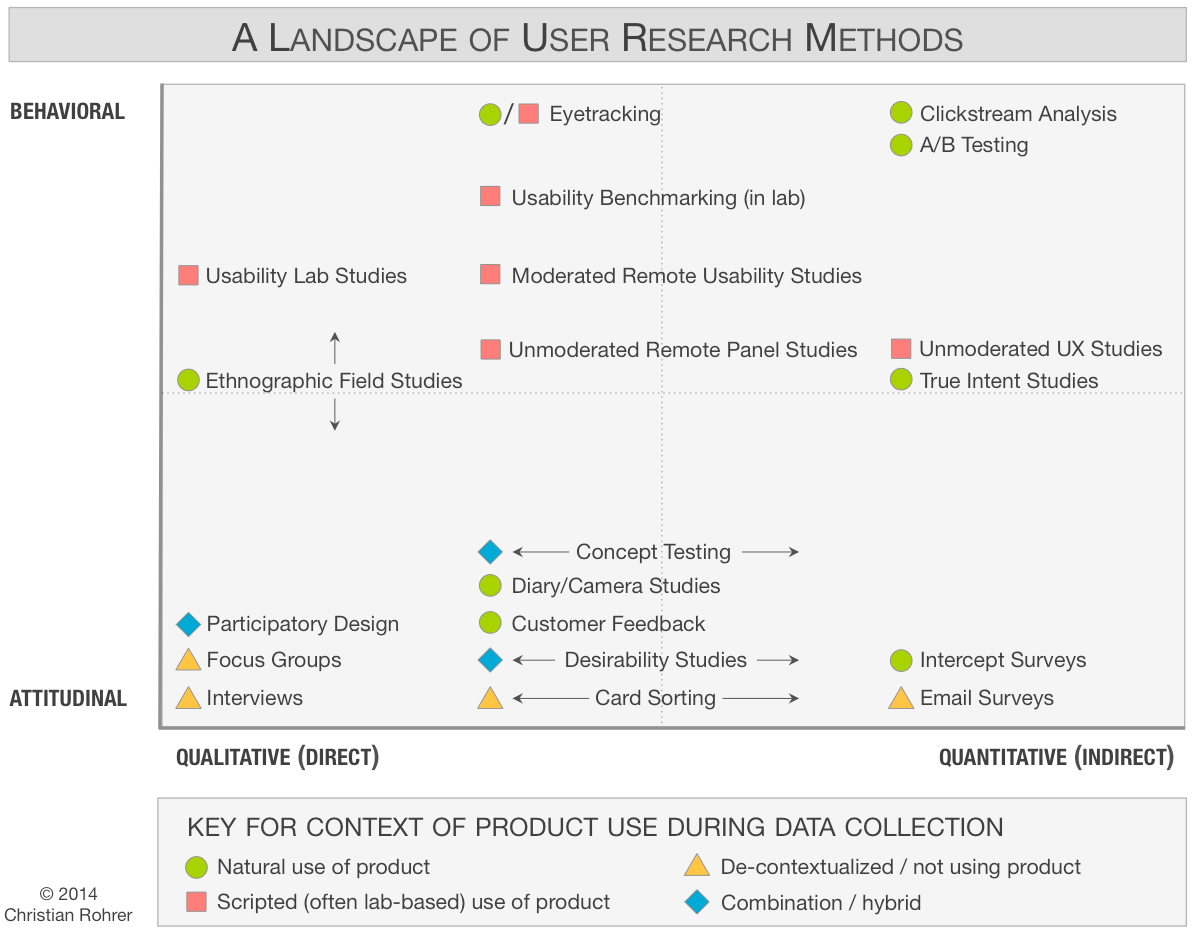UX research is an extensive field. UX researchers employ a wide variety of research methods, each one with its own purpose and rules. Therefore, when you’re working on a research project, choosing the right UX research method for the job depends on the type of insights you want to gather, as well as the time and budget available to you.
It’s not really possible to present a full list of all research methods, simply because they’re constantly evolving and researchers are coming up with new ones based on the needs of the changing world.
However, there are currently more than 20 popular ones out there, which we’ve compiled for your convenience in this overview. And even though each method uses a different approach to collecting information, they all have one common goal – understanding users better and using the obtained knowledge to improve how users interact with products.
Types of UX research methods
Before deciding on the right type of UX research method that will be best for your project, you need to define what is the goal of your study.
Do you want to find out how users interact with your product? Or ask their opinion on your new design? Or maybe just gather information about users and their behavior before the start of the design process?
Whatever it is that you want to find out from your research, start by defining it as a clear specific goal. This will help you choose the method that actually corresponds to your goal and so you don’t waste your time gathering useless information.
When you know what your goal is, it’s time to take a look at the methods which are available. Don’t forget that you can try most of them using some of the top UX research tools available online.
There are 4 main approaches to UX research. Two pairs of two paradigms standing opposite (though not incompatible) to one another:
- Behavioral vs. Attitudinal
- Qualitative vs. Quantitative
Let’s take a look at how they are different from each other.
Qualitative vs. Quantitative
Most UX research methods can be divided into 2 groups: qualitative and quantitative.
Qualitative research answers the “why” and “how” behind the user’s actions. It is usually conducted on a small number of testers and focused on uncovering users’ needs, expectations, pain points and real opinions.
Quantitative research, on the other hand, helps you answer questions like “how many” and “how much”. It collects numerical insights and allows you to assess the full scope of a problem.
Check out our Qualitative vs. Quantitative UX research guide where we explain the difference in-depth and give examples of both qualitative and quantitative research methods you could use in your project!
Behavioral vs. Attitudinal
These are 2 different approaches to UX research from another perspective.
Behavioral research aims to find out how users interact with the product, discover what they actually do in contrast with what they say. Some of the behavioral research methods include usability tests, session recordings, eye-tracking and similar.This type of research is indispensable if you’re researching how your users would act in real situations.
On the contrary, attitudinal research helps you gather insights about users’ opinions and thoughts about your product, uncover their struggles and needs. Some of the attitudinal research methods include surveys, user interviews and card sorting. Although this type of research has limitations when it comes to predicting behavior, attitudinal methods are still very useful for knowing what your users are thinking.
For example, you’ll want to know if people hate something about your product, even if it doesn’t technically prevent them from successfully using it.
A great way to explain the difference between the two is that behavioral methods research “what people do”, while attitudinal methods research “what people say”.
Here’s a handy chart by NN/group that perfectly illustrates the variety of UX research methods out there:

💡 When choosing a UX research method, you should also consider whether you want to conduct the study in-person or online with the help of a UX research tool. If you are unsure which method would be better for your current study’s objectives, check out our video about unmoderated vs moderated research below.
Top 8 UX research methods
Card sorting
Card sorting is a UX research method that involves asking people to sort individual labels into categories that make sense to them. It’s a great technique for improving the Information Architecture of a website or an app and fine-tuning its navigation.
Card sorting helps you get insights on content organization, labeling, categorization and hierarchy. It’s a great way for finding out how your users perceive the information on your website/app, what items they expect to be grouped together and how your categories should be named.
Check out our Card Sorting Guide where we explain more about the technique and its benefits and show how you can easily create your own free card sorting study!

Tree testing
Tree testing is principally the reverse of the card sorting method. In a tree testing study, participants are presented with a text-only version of your app’s/site’s information structure – typically a menu although it can be more abstract such as the site map and how the content is hierarchically organized into pages. You ask the participants to find certain information and they click through the tree to try and find the answer.
The results help you determine whether the structure of your website corresponds with how users expect it to be. Moreover, using tree testing you can find out where on a website users get lost and if they can actually find the desired information.
Usability testing
Usability testing is the process of testing your product with real users, giving them tasks to complete using your product and watching them interact with it. It’s crucial to conduct usability testing for either websites and apps and to do so throughout different stages of their creation.
Usability tests are a great way to find out what problems people face while using your product, what the actual interaction looks like, how they navigate it and search for certain items. Such tests can be conducted remotely, with the help of a specialized tool such as UXtweak, or in-person in the presence of a researcher.
Remote usability tests can be either moderated or unmoderated. Each of them have their own benefits and downsides. You can find out which one to choose for your study in our Moderated vs. Unmoderated Guide.
Session recording
While other UX research methods also involve watching real users interact with your product, session recording delivers the promise to its logical conclusion by recording actual user sessions from your website. It’s a great way of uncovering hidden usability issues or bugs on an already running website, since it allows you to see how users naturally behave and where they struggle.
Session Recording tools capture every click, scroll and movement of your user, which gives you deep insights into their behavior, since you can watch their journey from start to finish. On top of that, UXtweak’s tool also allows you to generate heatmaps for key pages.
User interviews
This UX research method is normally used in the early analytical stages of design in order to gain information about your end users, their needs, struggles and motivations. The insights collected during such interviews help teams make informed design decisions and build a product which is according to users expectations and more. It’s a quick and easy way to gather qualitative data, which makes interviews a very popular method among researchers.
Here’s a great article from NN/Group on the topic of user interviews, where you’ll find everything you need to know about this method. If you’d like to conduct user interviews with the use of UXtweak’s User Panel, contact us.
First click testing
First click testing is a method used to determine if a user’s first click on a website leads them in the right or an unexpected direction. It basically allows you to find out whether it’s clear tousers where they should click in order to reach their goal with your product.
First click testing is a perfect method for A/B testing and can be used in any stage of the design process.
Concept testing
Concept testing is a method that allows for very quick testing of your ideas before you spend energy developing them any further. It is used to validate concepts at any step before you present the product to the customers, allowing you to save money and time on later fixes. A concept can be anything – a verbal description for your idea for an app, a sketch of its main interface, a list of possible names for the app or its features, a beta of your app or anything else you can think of.
By running concept tests with the target audience, you can get feedback on your product early on and find out if it’s appealing to the people that it was made for. Check out our Concept Testing Guide to learn more about the method and how you can conduct all sorts of concept testing in UXtweak.
Surveys
Running a survey is one of the most common and straightforward UX research methods for gathering both qualitative and quantitative feedback from users. The information gathered in a survey is frequently used to improve digital products and conduct additional research.
You can use a survey to find out the level of user satisfaction with the product, their opinion about it’s design or a certain new feature. Your company’s communication is also part of the UX – feedback provided about your technical support is also UX research. As we can see, surveys are a universal, quick and cheap way of gathering feedback, especially when using a Survey tool.

